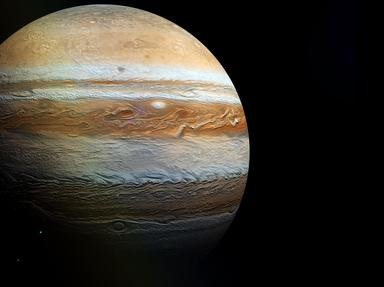Quiz Answer Key and Fun Facts
1. Jupiter generates more heat than it receives from the Sun, partially due to its high mass. What is one of the causes of this?
2. The Great Red Spot is a very well known hurricane on Jupiter. It is about the same diameter as Earth itself! Which of these is another storm on Jupiter?
3. The four largest moons of Jupiter are known as the Galilean moons. Which of these is not one of them?
4. Before they were officially named, the Galilean moons, then thought of as planets in their own right, were given temporary designations that showed they orbited Jupiter. One example is "The Saturn of Jupiter". Which of these was not one of the temporary names for the Galilean moons?
5. Besides the Sun and the Moon, Jupiter is the brightest object in the night sky.
6. Many centuries ago, a civilization called the Akkadians, like the Greeks and Romans after them, noticed that some "stars" were not stars at all, but were planets. They came up with names for each of the ones they could identify. What is Jupiter's Akkadian name?
7. What is unique, compared to other gas giants, about the way Jupiter orbits the Sun?
8. Two of Jupiter's average-sized moons, Adrastrea and Metis, are thought to have contributed material to what part of the Jovian system?
9. In 2007, the New Horizons space probe used the gravity of Jupiter to speed it up through space. Where was this space probe's destination?
10. On August 5th, 2011, a probe was launched to Jupiter to study what is below its atmosphere. What is the name of this probe?
Source: Author
jonthomas
This quiz was reviewed by FunTrivia editor
CellarDoor before going online.
Any errors found in FunTrivia content are routinely corrected through our feedback system.


